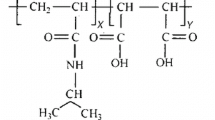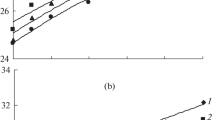Summary
For the experiments there have been prepared such microheterogeneous mixtures of isotactic polypropylene with polyethylene and of polyvinylchloride with polyethylene which contained maximum 60 volume per cent of dispersed phase component (iPP; PVC respectively) at 160°C for various diffusion times, whereat with sufficient exactness the tetrahedric lattice model could be applied. From the dependence of the mixture excess volume on dispersed phase volume fraction, calculated from additive and real densities, the volume fraction at the maximum dilatation (Φ m ) was determined. At supposing theFickian course of the mutual diffusion, it was possible to calculate the thickness of the interphase layer.
It was stated that for both polymer pairs the diffusion after 15 min had been practically stopped. This phenomenon, which could be explained by the kinetic hindrances during the interpenetration of the different nature polymer segments, is resulting in the deviation from theFickian course of diffusion.
Zusammenfassung
Zwecks Durchführung der Experimente wurden mikroheterogene Mischungen von isotaktischem Polypropylen mit Polyäthylen und von Polyvinylchlorid mit Polyäthylen vorbereitet, die höchstens 60 Vol.-% von dispergierter Phase (iPP oder PVC) bei 160°C für verschiedene Diffusionszeiten enthielten. Hierdurch konnte mit genügender Präzision mit dem Tetraeder-Gittermodell gearbeitet werden. Der Volumenbruch bei maximaler Dilatation (Φ m ) wurde aus der Abhängigkeit des Exzessvolumens vom Volumenbruch der dispergierten Phase auf Grund von additiven und tatsächlichen Dichten berechnet. Unter Voraussetzung desFickschen Gesetzes für die Diffusion war es möglich, die Dicke der Zwischenphasenschicht auszurechnen.
Man stellt fest, daß die Diffusion für beide Polymerpaare nach 15 min praktisch zum Stillstand kommt. Diese Erscheinung, die durch die kinetische Behinderung bei der Durchdringung von Polymersegmenten verschiedener Art erklärt werden könnte, ergibt Abweichungen vomFickschen Verlauf.
Similar content being viewed by others
References
Morozova, L. P. andA. N. Krotova, DAN115, 747 (1957).
Kamenskii, A. N.,Vysokomol. soyed.7, 696 (1965).
Voyutskii, S. S., A. N. Kamenskii andN. M. Fodiman, Kolloid-Z. u. Z. Polymere215, 36 (1966).
Crespi, G. andF. Ranalli, Polypropylene, Reprinted from Transactions68, 27 (1959).
Reilly, J. andW. N. Rae, Physico-chemical methods, p. 587 (New York, 1953).
Ibid.Reilly, J. andW. N. Rae, Physico-chemical methods, p. 598 and 648.
Supplement to Book of ASTM Standards, Part 9, 112 (Philadelphia 1960).
Voyutskii, S. S. andV. L. Vakula, Uspekhi Khimii33, 205 (1964).
Brdička, R., Základy fysikální chemie, p.223 (Praha 1952).
Author information
Authors and Affiliations
Additional information
With 2 figures and 1 table
Rights and permissions
About this article
Cite this article
Letz, J. Attempt for the diffused interphase layer determination from the volume changes of microheterogeneous polymer mixtures. Kolloid-Z.u.Z.Polymere 236, 38–42 (1970). https://doi.org/10.1007/BF02084511
Received:
Issue Date:
DOI: https://doi.org/10.1007/BF02084511




